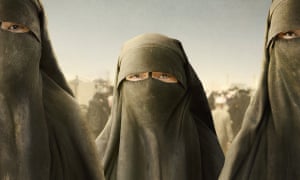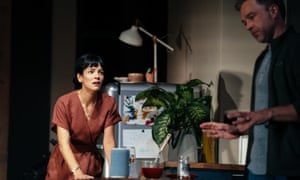Sabaya: the shocking documentary filmed inside Syria’s notorious al-Hawl camp
With car chases and shootouts, it may feel like a Hollywood action flick, but, as the director, Hogir Hirori, explains, the film is really about the exploited women and girls there

In August 2014, after Islamic State (Isis) militants attacked the Sinjar district in northern Iraq, Hogir Hirori realised his calling. Although he had been living in Sweden since 1999, his home town was only about two hours’ drive from Sinjar.
“When Daesh [Isis] attacked, I realised that I could tell these stories in a really specific way,” he says, speaking via video from Stockholm. “I knew the culture and the language, and I’ve been a refugee all my life, so I had the understanding and the insights to do these documentaries very well.” Hirori had trained in media production and worked in Swedish television, but he had never before addressed an international audience. The news coming out of Sinjar changed all that.
Sabaya is the third feature documentary Hirori has made about the consequences of war in northern Iraq, and the fate of the long-persecuted Yazidi people. In 2016, The Girl Who Saved My Life told the story of Hirori’s initial return to the region to document the refugee crisis; 2017’s The Deminer was a nerve-shredding portrait of a Kurdish bomb-disposal expert. In Sabaya, Hirori embeds with a group of unfathomably brave volunteers who infiltrate the dangerous al-Hawl detention camp in Syria in the hope of rescuing some of the estimated 7,000 Yazidi girls and women who have been sex-trafficked by Isis since 2014. The sprawling facility is home to more than 62,000 people, according to recent UN estimates, 80% of whom are women and children.
“It was actually my wife [Lorin Ibrahim] who had this idea to go down to Syria to find out what happened to these women and girls,” says Hirori. Ibrahim is a reporter for Swedish radio and, like her husband, has first-hand experience of life in a conflict zone. “She was 11 years old when she fled from Syria, and it took her three years to reach Sweden.” As the security situation in Syria deteriorated, the couple, who have two small children, changed their plans: “We realised that it was just too dangerous to bring anybody else in, so I decided that I was going to do everything, all the logistics, myself.”
Hirori has deep roots in this part of the world. Yet even he was unaware of the extent of what these kidnapped women – known as “sabaya” – had been through. “It was sort of a taboo to talk about,” he says. He has since come to understand the heavy significance of the term: “It’s been around since ancient times … [It] encompasses [the idea] that you have the right to take these girls in times of war and use them as you please: they clean your house, you can have sex with them.” The victims, too, are brainwashed into this way of thinking, as Hirori explains: “Almost all the young women I met were kidnapped at a very, very young age. They’ve told me: ‘But don’t you understand? We were traitors in our religion. We didn’t follow Islam, and this is God’s punishment; this is what we were destined to do.’ So that’s why it takes such a long time for them to get out of that mental state, and this hell that they’ve been living in.”
The plight of the Yazidis – recognised as a genocide by several international bodies – was widely reported on in 2014, but, seven years on, thousands of girls and women remain missing, abandoned by the rest of the world. This rescue mission has fallen to the Yazidi Home Center (YHC), a tiny volunteer organisation based in Syria and represented in Hirori’s film by Mahmud, a tall, stoic presence, who is constantly struggling for reception on his mobile phone, or in hushed conference with his colleague Ziyad. As Hirori is careful to point out, Mahmud and Ziyad are not the only ones engaged in this urgent work. Indeed, it is the women who go undercover to infiltrate the al-Hawl camp – many survivors of trafficking themselves – who take on the greatest risk. For safety reasons, Hirori says, their names and images could not be included in the film. “We decided only to make a portrait of Mahmud and Ziyad. But it’s important for me not to raise anybody up as a hero. I just wanted to document exactly what was going on in their everyday lives.”
Even so, the YHC had serious reservations about allowing Hirori to film at all. “They told me afterwards that, in the beginning, they were trying to find some kind of white lie, to derail me from doing this documentary. But we established a very good relationship after a while. We had to trust each other in the dangerous situations that we were put in.”
That danger is abundantly obvious in the film: car chases, shootouts and tense interrogations. It’s the kind of excitement usually seen in Hollywood action films, with one important distinction: everyone remains oddly calm. “I showed a clip to my producer [Antonio Russo Merenda] of a shooting going on, and I had to explain to him why nobody was panicking, like they do in the movies.” Even the horrors of war can become normalised with repetition: “Somebody is getting shot, somebody is getting stabbed, these noises are everywhere and you just don’t become surprised any more. You try to subdue your inner fear, to keep a collective calm, to get through a situation.”
Sadly, in al-Hawl, smuggled guns are a much more common sight than smuggled cameras; this presented Hirori with a practical challenge: “Every time I tried to film in the central square, everybody just gathered around me.” He experimented with using his iPhone instead, holding it to his ear and pretending to talk into it. “But those images didn’t really turn out well.” Another idea, to strap a hidden camera to his body and enter the camp alone, was vetoed outright by the YHC as too dangerous. In the end, Hirori disguised the camera and himself in a niqab (the full-length black veil worn by almost all women in al-Hawl), and entered the camp among the female infiltrators. This produced the distinctive hidden-camera footage that bookends the film, though it’s not as innovative a solution as you might have assumed: “It turns out that a man who had stabbed a member of the security police was wearing a niqab,” says Hirori. “Men very often use the niqab to disguise themselves and enter the square, mainly to gather information and just check things out.”
Sabaya isn’t all such high drama. After rescue, the women are usually taken to Mahmud’s home to begin the long process of recovery, while the YHC works to find more permanent accommodation. It’s here that we meet Mahmud’s sweet and cheeky young son Shadi, and his mother, a welcoming woman who takes great delight in setting discarded niqabs alight as Shadi pokes the pyre with a stick. (“May God eliminate these clothes!”) These are moments of light relief for the audience, but that’s not the main reason for their inclusion, says Hirori. “That part is very important in the recovery of the girls; going back to normality and normal family life. I also wanted to show the humanity and kindness of Mahmud’s family there. They’re not rich people – they’re very poor – but they do share anything that they have with all these women who come to live with them, and anybody else.”
Hirori himself also often stayed at Mahmud’s home during filming. “I could wake up in the morning and do some cleaning in the house, maybe cook the meal. I spent time playing with the children, talking to anybody.” Slowly, some of the women felt comfortable enough to discuss their traumatic experiences on camera, and these were two-way conversations. “Before I started making these documentaries, I didn’t talk to anyone about my experiences as a refugee, I was very much closed about it,” says Hirori. “It’s just history repeating itself, over and over again. My dad experienced the same thing, and my grandfather experienced the same thing.”
With the release of Sabaya, the third in this unofficial trilogy, does Hirori now feel these women’s story – and his – have been fully told? “After each and every one of my films, I’ve thought: ‘OK, this was the last, and now I just want to focus on being with my family and living my life in Sweden.’ Then something happens, and I feel I have to go back again.” He gives a rueful smile. “So, here I am, again, saying that this is the last film and now I’m going to focus on my normal life.”
Sabaya is released on 20 August.



